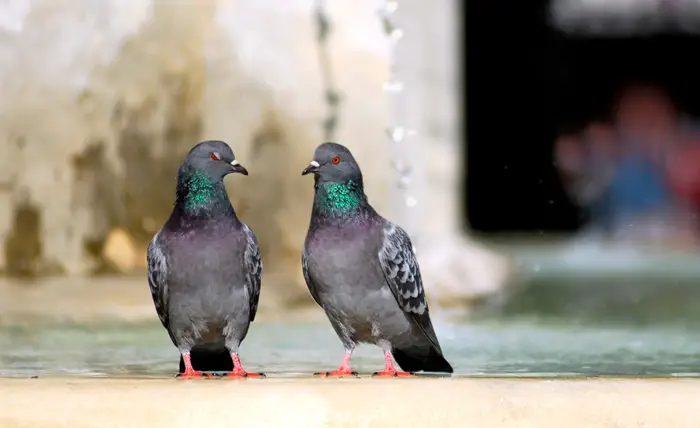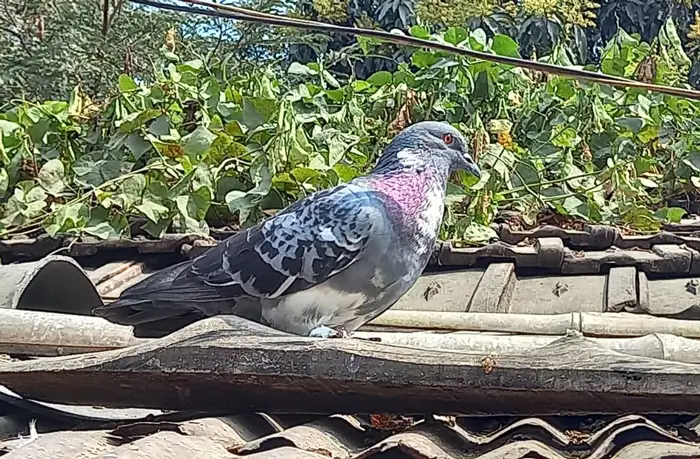Rock Pigeons 101: Physical Characteristics, Habitat, Behavior, and Interaction with Humans
The scientific name of rock pigeons is Columba livia, and they belong to the Columbidae family. These birds have a plump body that is larger than a mourning dove. The plumage has variable colors, mostly bluish-gray with black stripes on the wings. But spotted, plain, or pale plumage is also available.
Rock pigeons or common pigeons are seen nesting in buildings that resemble high cliffs in the wild. They are a big part of the urban ecosystems, which support many birds of prey. Learning the negative impact of their excretion on infrastructure is also crucial.
In this detailed guide, we will talk about rock pigeons’ physical characteristics, habitat, and rock pigeon behavior. You will also learn about their pigeon-human interaction and some interesting facts about rock pigeons. From appearance to mating behavior, everything will be covered in detail. Let’s get started.
Rock Pigeon Physical Characteristics

You need to learn about their physical characteristics to identify rock pigeons. Here is a detailed overview.
Appearance
- Rock pigeons or rock doves are usually smaller than a crow. But they have a plump and beautiful body that makes them larger than mourning doves
- They measure about 30-36 cm in length and weigh about 265-380 g.
- The average wingspan of rock pigeons is 50-67 cm.
- The color pattern of the plumage is an easy way to identify the bird. Most birds will have blue-gray plumage with double black wing bars
- The tail tip is also black. Some birds may have dark or pale spots instead of wing bars. And some birds might not have any spots at all
- They have a thin bill with a grey-black combination
- You will commonly see purple-red feet in rock pigeons
Species Variations
You will see nine more species in the Columbidae family. Among them, white-crowned pigeons are known for the white patch on their head. Common ground dove with gray-black plumage is also common. Eurasian or African collared-doves have black collars on their necks.

Adaptations of Rock Pigeons
The natural rock pigeon habitat is cliff areas in the wild. So, they are familiar with almost-vertical takeoffs, which they find easier in between city buildings. Dodging their predators in the city is also similar to that in high mountains.
Plus, rock pigeons have developed their maneuverability for urban ecosystems. These adaptations make these pigeons highly suitable as city birds. In this world of fast urbanization, rock pigeons find it much easier to flock around in cities to forage for food.
Habitat and Behavior of Rock Pigeons
The most common pigeon habitats in urban ecosystems are flat surfaces in buildings. They also prefer window ledges or open beams for nesting. You might find them in parks, lakeshores, farmlands, etc. Though their original habitat is in the wilderness, they aren’t usually seen in dense forests.

Nesting Behavior
While building nests in urban or suburban ecosystems, male pigeons tend to collect all the nesting materials, usually twigs and grass. Female pigeons are responsible for building nests, and they use the same nest over and over again.
When a new brood arrives, they tend to add more nesting material to the existing nest to accommodate the brood.
Mating Behavior
Pigeons are usually monogamous, so they mate for life. You might find male pigeons spreading their tails, puffing up their chest, and circling around female pigeons. This is a common pigeon behavior in many species.

They might bow or coo to attract the partner. Pigeon parents raise an average of five broods. And it takes about 16-19 days for the eggs to incubate.
Feeding and Social Behavior
Pigeons are usually seen in flocks. Whether it is time for feeding or roosting, pigeons will flock and walk in a steady direction. They will also bob their heads back and forth while flocking. Rock pigeons will usually feed early in the morning and afternoon.
Role of Rock Pigeons in the Urban Ecosystem
People studying bird ecology might find it interesting that rock pigeons play an important role in the urban ecosystem, where these pigeons are ubiquitous. They are the primary prey birds for many predators. In some cases, these birds are domesticated for egg and meat production.
Interaction with Humans
A quick fun fact, rock pigeons were the first domesticated bird in the history of mankind. Though these birds are native to southern Asia, Europe, and North Africa, they were brought to North America approximately 400 years ago.

Since then, rock pigeons have been seen to prefer areas with the human alteration. And they have been used in various sports. For example, using rock pigeons as messengers was a very popular sport, which dates back to 3,000 years. Rock pigeons were also used in the ancient Olympics. Here is a quick overview of rock pigeon-human interaction.
Interactions While Feeding and Roosting
Rock pigeons are quite familiar with human movements, so they don’t seem to be bothered in crowded areas. If you offer them food, they might watch it a bit and then gladly accept the offering. It is a typical bird behavior for most pigeons.
They usually eat various seeds and grains. But you will also see them eating popcorn, peanuts, bread, etc., in parks or streets. And they roost in high perches to avoid attacks from predators. You might hear them cooing in the night, which is a form of communication to alert other pigeons in the vicinity.
Negative Impacts of Rock Pigeons
Due to the abundance of the species, problems like health risks and infrastructural damage have increased. According to research institutions, rock pigeons cause damage worth approximately 1.1 billion dollars annually. The main problem is the acidic excreta caused by a human-influenced diet.

They excrete a lot, and that acidic substance can cause damage to building structures. Plus, their nest materials cause drainage systems to clog. Loss of grains from farmlands or cities is also a huge problem.
And rock pigeons can spread various diseases through their excreta and parasites. Rock pigeons can spread influenza, tuberculosis, aspergillosis, paratyphoid, and many other diseases. This species can also spread diseases among native and domestic species in that ecosystem.
Controlling Rock Pigeon Populations
Managing city bird populations is crucial to maintaining the balance between ecosystem species. Many conservation organizations work to control the pigeon population in urban and suburban areas.
Capturing pigeons and transferring them to new locations is a common method of controlling rock pigeon populations.
But pigeons have homing capabilities, so they often tend to get back. Making food sources scarce is also an effective method of forcing pigeons to search for new locations.
Interesting Facts About Rock Pigeons

Here are some interesting facts that are little known to most people. See if you know them.
- According to Mesopotamian cuneiform tablets, the domestication of rock pigeons happened about 5,000-10,000 years ago
- In World War I and II, rock pigeons worked as flying messengers in the US Army Signal Corps
- Pigeons have extraordinary homing abilities. Even if you blindfold a pigeon and leave it in an unknown place, it will find its way home with the help of the sun’s orientation, geomagnetism, smells, and landmarks along the way
Conclusion
Rock pigeons are plump birds with commonly blue-grey plumage and double black wingbars. In the wilderness, cliff areas are natural habitats of rock pigeons. So, they prefer flat surfaces or ledges on buildings in urban ecosystems.
Though rock pigeons are important for the ecosystem, they cause infrastructural and health damage. So, you should be aware of various methods to control pigeon population.
Come forward to prevent the negative impacts of the species on the environment and infrastructure through vast research and the latest strategies. And learn more about the importance of rock pigeons in the urban ecosystem.






